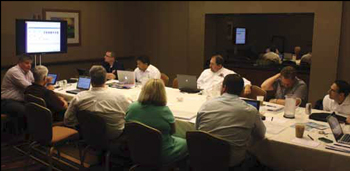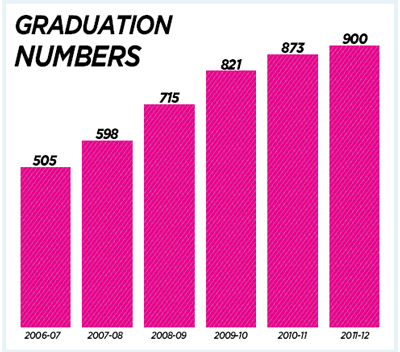Blended Learning

Like many of the inside baseball terms tossed about the edtech space, “virtual” and “blended” learning mean different things to different audiences. Ask your superintendent how she defines “blended learning.” Now ask your PTO president. Ask a school parent. Like other terms in our space, from “disruptive tech” to “21st-century skills,” odds are you will get different answers from each of these audiences—if they can define them at all. This was the challenge presented to the “Virtual and Blended Learning” work group at the second SchoolCIO Summit Conference in La Jolla, CA. Here are their stories.
Hall County Schools, GA
Presenter: Dr. Aaron Turpin, Executive Director of Technology.
“Begin with the assessment,” says Turpin of transitioning to a blended learning environment. “What system and criteria will you use to evaluate students and teachers? And most important: collaborate with other districts. You have to to survive.”
The challenge: Hall County introduced a BYOT program two years ago that was the core of their transition to a blended learning environment. Turpin admits to implementation challenges: training; rethinking when/where learning takes place; assessments; synchronicity; and the biggie: state and local policies.
The solution: Turpin credits the leadership of school principals, coupled with the Dell Learning Platform, with helping the schools transition to a blended environment. He says the principals encouraged asynchronous, personalized learning and collaboration through social networking tools, and let school communities know that school was no longer just 8 to 3. They also moved their wealth of resources to the Dell Learning Platform, which allowed the school community to share and collaborate, as well as more easily transition to Common Core resource requirements.
Tools They Use
Dell Learning Platform
Brainhoney LMS
Infinite Campus SIS
SAFARI Montage
CK12
PhET
Kahn Academy
Edgate
Brain Pop
Discovery Ed
Tools and ideas to transform education. Sign up below.
Cedar Hill ISD, TX
Presenter: Kyle Berger, Executive Director of Technology
“Schools are a business and have to market themselves,” says Berger. “We can ‘brand’ our education and give it value.”
The challenge: Bring more online resources to the ethnically diverse Cedar Hill ISD, which includes a large community without Internet access.
The solution: The district partnered with community corporations to open storefront learning centers. These storefronts serve as resource centers to support online classes and expand opportunities for those without connectivity ability at home. The front of the store sells school supplies; the back of the store houses computer labs for the community.
Tools They Use
PLATO Learning
Project Share
TX-Vision
SAFARI Montage
Skyward
Joplin Schools, MO
Presenter: Traci House, Director of Technology
“Getting buy-in from teachers was essential to the success of the program,” says House. “It was not for everyone, but it is with great satisfaction that I say that our hard work and cooperation paid off—the laptop distribution was a complete success.”

The challenge: Less than two hours after the Joplin (MO) High School graduation ceremony had drawn to a close in 2011, a tornado destroyed five district schools, including more than 60% of the district’s aerial fiber.
The solution: The aftermath was devastating, but it created a unique opportunity for Joplin. “Because Joplin had lost everything,” Traci House says, “we could essentially start over.” Rather than replacing textbooks, the schools switched to an opensource, all-digital curriculum. They hired five coaches to do a huge amount of PD in a few short weeks. The Joplin team worked like mad and by the first day of school, the schools opened successfully, including a 2,200 laptop program.
Tools They Use
Macbooks
Blackboard
Skype
Google Apps
Costliest Tornado in US History
8,000
Homes damaged or destroyed
400
businesses damaged or destroyed
18,000
vehicles damaged or destroyed
Additional Participants:
Sean McDonough
Chief Technology Officer, Allegheny Intermediate Unit, PA
John Alawneh
Executive Director of Technology, Austin ISD, TX
Richard Valerga
Chief Information Officer, Memphis City Schools, TN
Steven Engravalle
Superintendent, Fort Lee, NJ
Sunnyside Unified School District No. 12, AZ
Presenter, Manuel Isquierdo, Superintendent
The challenge: To change Sunnyside USD from a dropout factory to a successful model school that brought 120 dropouts back to school to learn through online courses.

The solution: “Project Graduation: The Digital Advantage,” a laptop giveaway program for deserving students that focused the entire community on graduation as the primary goal. Since implementing the program, the district has increased its graduation numbers from 505 in 2007 to 873 in 2011.
The program has motivated 2,500 students to keep up in academics, extracurricular activities, and attendance as a result of earning a laptop. Another 650 students are expected to receive free laptops this school year.
“The Web is breaking out of the computer and into the world. Things will start to tell you about themselves.”
“Its not a money issue. It’s that schools aren’t spending their money well.”
“The ideal PD would allow four days at school and one day to learn online while teachers do PD.”
“What this all means for schools is we need to focus on good infrastructure.”
“Vendors should use lobbying dollars to focus on edtech. We’re going up against wellfunded teacher union lobbyists.”
